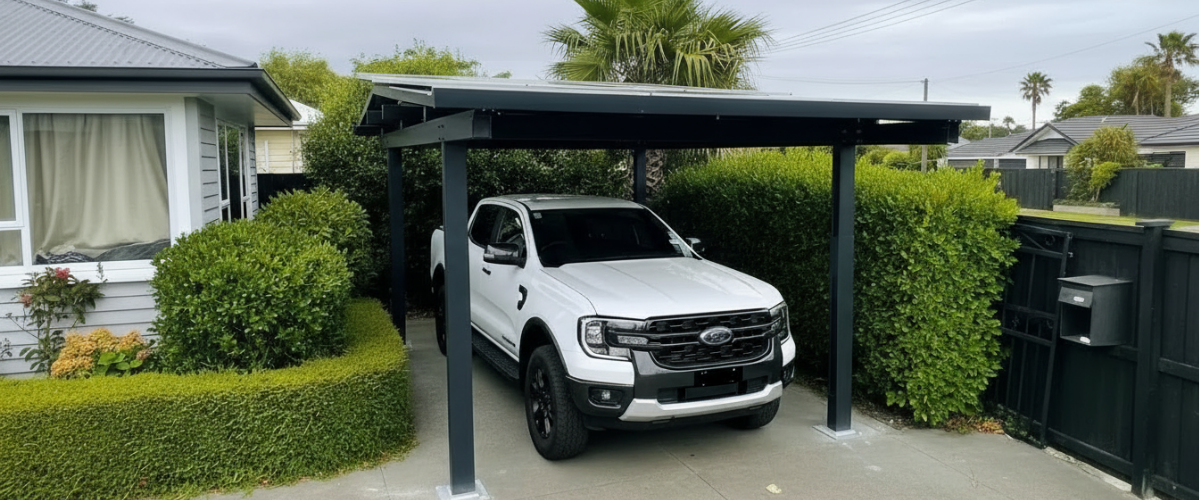Why 2025 Is the Year to Invest in a Solar Carport in SoCal

Solar and Roofing Advisor
Rising rates and 30% solar tax credit ending soon makes now the best time to install a solar carport. Build a carport that powers your EV and lowers your bills.

As Southern California homeowners explore every option to cut energy costs and gain resilience, one emerging trend deserves serious attention: the solar-carport. A solar carport is a standalone canopy structure, typically built over a driveway or parking space, with photovoltaic (PV) panels mounted overhead. It combines clean energy production with a shaded parking area—two distinct benefits in sun-soaked regions like Los Angeles, the San Fernando Valley and surrounding suburbs.
This article examines how solar carports stack up: what they cost, the incentives available, how they compare to rooftop solar, and why, for many homeowners, they may offer compelling value right now. It concludes with how US Power uses its exclusive partnership with Qcells to deliver high-efficiency, American-made panels and factory-direct pricing, making the investment easier.
Why a Solar Carport Makes Growing Sense
Dual-benefit structure
First, the value of a solar carport is two-fold. A driveway canopy with PV panels:
- Provides clean electricity generation.
- Offers shade/high utility for vehicles (and reduces heat gain on the pavement/garage).
In Southern California’s hot summers, a shaded carport can lower cooling loads (for the vehicle and possibly adjacent garage) and offer a nicer parking experience. Meanwhile the solar canopy is maximising space which otherwise sits unused.
Better orientation & fewer roof constraints
Unlike many roofs, which may face sub-optimal angles, have shading, or require reinforcements, a carport can be oriented, tilted, and built for optimal solar exposure. That means more kWh generated per installed watt. And because it’s not tacked onto, say, an aging roof needing replacement, it avoids certain complications.
Storage- and EV-ready
For homeowners installing a battery-storage system and/or planning to add an EV charger: a carport becomes an ideal base. The solar generation can feed the battery or EV charger; the carport’s physical structure facilitates wiring and placement of equipment. That makes the carport especially relevant to the growing EV market in California.
Property value & aesthetics
While data is less granular for carports than rooftop systems, any solar-enabled structure tends to increase home value—especially when paired with premium panels, a clean installation, and warranty support. Also, visually a well-designed carport can look more intentional than ad-hoc rooftop panel installations.
What It Costs & What to Expect for Homeowners
Installed cost scenario
While detailed residential-specific carport cost data is thinner than rooftop data, key sources show that solar carports are more expensive per watt than standard rooftop installs due to the structural framing, foundations, and permitting complexity. For example:
- Commercial carport‐system sources note that “several government incentives … can help offset the cost” and highlight the increased structural cost in Southern California.
- One popular solar-carport article states homeowners “are eligible for the federal solar tax credit, which is currently valued at 30% of the system’s installation cost.”
- For California rooftop systems: According to SolarReviews, the average pre-incentive cost of a typical ≥7.2 kW system is ~$22,608 before incentives, and ~$15,820 after applying the 30% federal credit.
Based on these numbers, a homeowner installing a carport canopy of say 6–8 kW capacity might expect:
- Higher than typical rooftop cost per watt (maybe 10-30% more or more).
- But still a pay-back horizon that can make sense given Southern California’s strong solar resource and growing utility costs.
Incentives and payback
Federal tax credit: The residential clean energy credit (formerly the ITC) currently allows homeowners to claim 30% of qualified solar costs—including panels, labor, inverter, and batteries—when they own the system. irs.gov+2EcoFlow+2
For California homeowners:
- SolarReviews shows the 30% federal credit applies (for systems placed in service in 2025) and can reduce the cost of a mid-sized system significantly.
- Additional state-level benefits: While big statewide rebates are largely gone, programs such as the Self-Generation Incentive Program (SGIP) provide battery-storage incentives; California also offers a property-tax exclusion for solar installations (so your home’s property tax doesn’t rise because of added solar value).
Key takeaway: If a homeowner installs a solar carport now (2025 timeframe) in Southern California, they benefit from the full 30% tax credit and strong solar yield. Delay may mean higher costs, slower approval and less favourable grid-rates.
Relative payback
Because solar carports generate power and potentially offset vehicle charging and daytime usage, a pay-back of ~7-12 years is often cited in ideal cases (high sunlight, good orientation, utility rate escalation, battery/EV synergy). For homeowners staying in the home 10+ years, this can be a strong investment.
Risks and conditions to evaluate
- Driveway/space availability: You need enough room for the canopy—width, height clearance, and set-backs need permits.
- Permitting & structural costs: Carports involve structural engineering, possibly deeper footings, wind & seismic compliance (especially in California).
- Utility interconnection and rate structure: With the arrival of Net Energy Metering (NEM) 3.0 in California, compensation for solar exports is less generous; pairing with batteries may be wise.
- Home-owner association (HOA) or local zoning approvals: The carport may require additional local approvals compared to rooftop panels.
- Roof vs carport trade-off: For homes with a good roof and minimal shade, rooftop systems may still remain simpler and cheaper per watt.
Why Now is a Good Window for Southern California Homeowners
Rising utility rates
Southern California homeowners face increasing utility rates—and time to hedge against further escalation is limited. Installing solar with shelter (carport) and capacity for battery/EV means locking in lower cost energy for decades.
Tax credit timing
Although some sources suggest the 30% credit may phase down after 2032, for residential systems completed through 2032 the full credit is still available. However, other commentary warns of a rush and potential changes in soft-costs and workload, meaning homeowners who wait may face higher costs and delays.
EV adoption synergy
Southern California boasts one of the highest concentrations of EVs in the U.S. A carport is almost tailor-made to feed an EV charger, mount battery storage, and supply ancillary services like shaded parking. The dual-use of shade + solar + EV makes it especially smart.
American-made and premium panels matter
For long-term homeowner value, choosing high-efficiency, American-made panels—such as those from Qcells—can yield better durability, stronger warranties, and higher resale-value. That makes the higher up-front cost of a carport more palatable when paired with premium equipment.
How US Power and the Qcells Partnership Unlock the Value
At US Power, Southern California homeowners gain access to a full-service solution: site analysis, permit management, structural design (carport or rooftop), installation, battery storage integration, and maintenance. Key differentiators:
- Exclusive partnership with Qcells: Enables factory-direct pricing on premium, American-made panels.
- High-efficiency systems: Ensures homeowners get more kWh per watt installed—crucial for cost-effectiveness of a carport.
- Battery-ready architecture: Carport installations are inherently well suited for later battery add-ons, ensuring the system remains flexible for EVs and grid-resilience.
- Local expertise in Southern California: Familiarity with the permitting ecosystem, HOA requirements, and utility interconnection in LA County, San Fernando Valley, and broader SoCal.
- Deadline-aware for incentives: US Power helps homeowners navigate timeline and paperwork so they fully capture federal credits and other local incentives.
In short: instead of the homeowner assembling separate engineers, structural contractors, solar installers and battery integrators, US Power delivers the turnkey solution—with the carport option as a premium alternative to rooftop when space allows.
Is a Solar Carport Right for You? A Checklist
Use this checklist to evaluate whether a solar carport makes sense for your home in Southern California:
- Do you have sufficient driveway/parking space (width, height clearance, minimal shading) to build a carport canopy?
- Does your roof have significant shading, unfavorable orientation, or need replacement soon (which might make carport more attractive)?
- Are you planning to stay in your home for 8-12 years or more (to recoup the investment)?
- Do you anticipate owning an EV now or soon, or desire battery-storage for resilience/outages?
- Are you willing/able to commit to installation in the next 6-12 months (to optimise incentive timing, utility interconnection, and cost escalation)?
- Have you compared the cost per watt of a carport vs a rooftop system in your neighborhood, factoring structural/permitting premium and expected kWh yield?
- Are you working with an installer who uses premium panels (such as Qcells), handles structural & electrical engineering, and has strong local credentials?
If you answered “yes” to many of these, a solar carport may well be a high-value investment for your household.
What to Look for in a Design & Installer
When moving forward, be sure to ask:
- What is the panel efficiency and warranty (e.g., Qcells panels: premium tier)?
- What structural framing is specified (wind/seismic compliant for LA County)?
- Are foundation/footing costs, permitting, HOA review, utility interconnection fees included?
- Is battery-storage and EV-charger integration planned (even if installed later)?
- What is the expected energy yield (kWh/year) given shading and orientation?
- What is the full cost per watt, and payback estimate given local utility rates and net-metering/export structure?
- How will the installation address local incentive deadlines (federal credit, SGIP for batteries) and how will tax-credit paperwork be handled?
- What ongoing operations/maintenance support is provided (cleaning, monitoring, panel warranty, inverter replacement)?
An experienced SoCal installer like US Power will handle the end-to-end process and provide the projections you need to make an informed decision.
Transform Your Driveway into a Solar Asset
For Southern California homeowners, this moment offers a unique window of opportunity: versatile solar carports that combine shaded parking, premium solar generation, battery/EV readiness—and strong incentive timing. With the 30 % federal Residential Clean Energy Credit still applicable and utility rates trending upward, now is an excellent time to act.
Partnering with a trusted local installer like US Power gives access to premium QCells panels, expert carport design, battery integration, and full service from permitting through activation.
Ready to turn your driveway into a revenue-generating, energy-producing asset? Schedule a FREE Assessment and Quote!
Take the first step to energy independence, savings, and resilience.
Frequently Asked Questions
Related Articles
Our Related Blogs
Tesla charging, Supercharging, and solar energy savings made easy for homeowners.
See how many Qcells solar panels you need for home and charge your EV energy.
Learn and choose the right car and reduce fuel and electricity costs in 2025.
Our Solar and Roof Brand Partners








We empower communities and businesses to harness clean, renewable solar energy solutions that drive sustainable growth.
Ready to Own Your Power? Call us today!
818-650-8010
Copyright © 2025 US Power - Axia by QCells. All Rights Reserved.
Privacy is important to us, so you have the option of disabling certain types of storage that may not be necessary for the basic functioning of the website. Blocking categories may impact your experience on the website.
Essential
These items are required to enable basic website functionality.
Personalization
These items allow the website to remember choices you make (such as your user name, language, or the region you are in) and provide enhanced, more personal features.
Marketing
These items are used to deliver advertising that is more relevant to you and your interests.
Analytics
These items help the website operator understand how its website performs, how visitors interact with the site, and whether there may be technical issues.
We and our third-party partners use cookies and other technologies to enhance and track your experience on this site, conduct analytics, and personalize marketing to you. By using the site, you agree to our use of these technologies, including recording and monitoring your interactions with the site.
Get an instant solar estimate using satellite!









